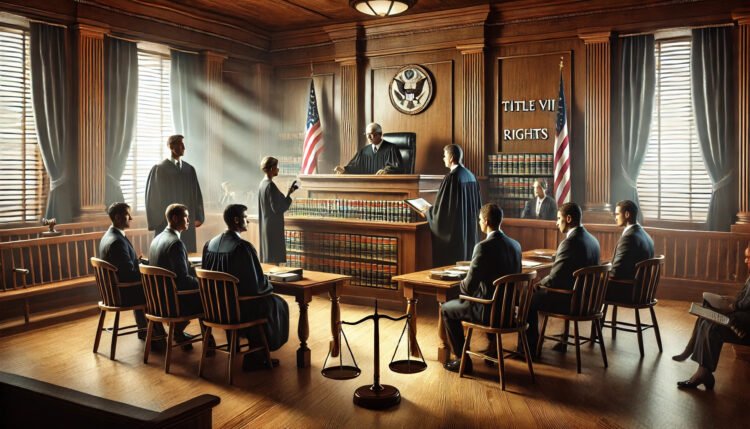Introduction
The Ninth Circuit Court of Appeals recently delivered a significant decision in Okonowsky v. Garland, addressing the scope of Title VII of the Civil Rights Act of 1964 in hostile work environments. The court reversed a district court’s summary judgment, highlighting the comprehensive approach needed in evaluating workplace harassment, especially concerning digital harassment and employer responsibilities.
Understanding Title VII and Hostile Work Environment
Title VII of the Civil Rights Act of 1964 prohibits employment discrimination based on race, color, religion, sex, and national origin. Under this statute, it is illegal to discriminate in terms of employment, including hiring, firing, promotion, and other conditions of employment. A critical aspect of Title VII is its provision against workplace harassment, which includes creating a hostile work environment.
A hostile work environment arises when discriminatory conduct based on the protected categories under Title VII is severe or pervasive enough to create an intimidating, hostile, or offensive work environment. Such conduct must be both objectively offensive (reasonable person standard) and subjectively offensive (actually perceived as hostile by the victim). The behavior can include unwelcome comments, jokes, or actions that target an individual’s protected characteristics.
EEOC Guidance on Harassment
The Equal Employment Opportunity Commission (EEOC) provides detailed guidance on what constitutes harassment under Title VII. According to the EEOC, harassment becomes unlawful when:
- Enduring the offensive conduct becomes a condition of continued employment.
- The conduct is severe or pervasive enough to create a work environment that a reasonable person would consider intimidating, hostile, or abusive.
The EEOC’s guidance clarifies that harassment can include actions, verbal statements, and written communications, including digital forms such as emails, social media posts, and other online activities. Employers must take reasonable steps to prevent and correct harassment; failure to do so can result in liability.
The Case: Okonowsky v. Garland
In Okonowsky v. Garland, Lindsay Okonowsky, a psychologist at a federal prison, alleged that she experienced a hostile work environment due to a series of sexually explicit and derogatory Instagram posts made by corrections Lieutenant Steven Hellman. The posts, which targeted her and other women, were visible to numerous prison employees, including management.
The district court initially granted summary judgment in favor of the government, stating that the harassment was not severe or pervasive enough to constitute a hostile work environment under Title VII. The court focused narrowly on specific incidents and did not adequately consider the broader context of the workplace environment and the cumulative effect of the harassment.
Ninth Circuit’s Reversal: Key Findings
The Ninth Circuit reversed the district court’s decision, emphasizing several vital points:
- Totality of Circumstances: The appellate court criticized the district court for not considering the totality of circumstances. The Ninth Circuit reiterated that all relevant conduct, including non-direct harassment and management’s responses, must be assessed to determine if a hostile work environment exists.
- Digital Harassment: The court recognized the significance of digital harassment, noting that social media and other online platforms can contribute to a hostile work environment. The court emphasized that such harassment need not occur within the physical confines of the workplace to be actionable under Title VII.
- Employer Responsibility: The Ninth Circuit underscored the importance of employer action in response to harassment complaints. The court found that the BOP’s response, which included delays in addressing Okonowsky’s complaints and inadequate measures against Hellman, was insufficient. The employer’s failure to act promptly and effectively exacerbated the hostile environment.
EEOC’s Role and Guidance Application
The EEOC is critical in enforcing Title VII and providing guidance on preventing workplace harassment. The EEOC’s guidelines stress the importance of employers creating a clear anti-harassment policy, training employees and supervisors, establishing complaint procedures, and taking immediate corrective action when harassment is reported.
In Okonowsky v. Garland, the Ninth Circuit’s decision aligns with the EEOC’s guidance, highlighting employers’ need to address all forms of harassment comprehensively. The decision reiterates that employers must take digital harassment seriously and recognize its potential to contribute to a hostile work environment.
Practical Implications for Employers and Employees
The ruling in Okonowsky v. Garland has several practical implications:
- Broad Definition of Workplace: Employers must understand that the definition of the workplace extends beyond physical locations. Digital communications and social media activities can also create a hostile work environment.
- Proactive Employer Actions: Employers are encouraged to implement robust anti-harassment policies, including guidelines for digital behavior. Regular training and precise reporting mechanisms are essential.
- Comprehensive Response to Complaints: Employers must respond promptly and effectively to harassment complaints. This includes taking appropriate disciplinary actions and protecting the victim from further harassment.
Conclusion
The Ninth Circuit’s decision in Okonowsky v. Garland broadens the understanding of what constitutes a hostile work environment under Title VII. It underscores the importance of considering the totality of circumstances and the impact of digital harassment. The ruling serves as a critical reminder for employers to take comprehensive measures to prevent and address workplace harassment.
For more information and legal support on workplace harassment issues, visit The Sanders Firm, P.C.. We provide comprehensive guidance and representation to ensure a fair and respectful workplace for all employees.





